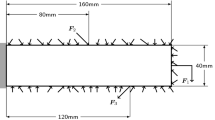Abstract
In this paper, the problem of load uncertainty in compliance problems is addressed where the uncertainty is described in the form of a set of finitely many loading scenarios. Computationally, more efficient methods are proposed to exactly evaluate and differentiate: (1) the mean compliance or (2) any scalar-valued function of the individual load compliances such as the weighted sum of the mean and standard deviation. The computational time complexities of all the proposed algorithms are analyzed, compared with the naive approaches and then experimentally verified. Finally, a mean compliance minimization problem, a risk-averse compliance minimization problem, and a maximum compliance-constrained problem are solved to showcase the efficacy of the proposed algorithms. The maximum compliance-constrained problem is solved using the augmented Lagrangian method and the method proposed for handling scalar-valued functions of the load compliances, where the scalar-valued function is the augmented Lagrangian function.










Similar content being viewed by others
References
Ben-Tal A, El-Ghaoui L, Nemirovski A (2009) Robust optimization. Princeton University PressPrinceton University PressPrinceton University Press, Princeton
Bendsoe MP (1989) Optimal shape design as a material distribution problem. Struct Optim 1(4):193–202
Bendsoe MP, Sigmund O (2004) Topology optimization: theory, methods and applications, 2nd edn. Springer, Berlin
Bertsekas DP (1996) Constrained optimization and lagrange multiplier methods. Athena Scientific, Cambridge
Bertsimas D, Brown DB, Caramanis C (2011) Theory and applications of robust optimization. SIAM Rev 53(3):464–501. https://doi.org/10.1137/080734510
Bezanson J, Edelman A, Karpinski S, Shah VB (2014) Julia: a fresh approach to numerical computing. IAM Rev 59(1):65–98
Brittain K, Silva M, Tortorelli DA (2012) Minmax topology optimization. Struct Multidisc Optim 45(5):657–668. https://doi.org/10.1007/s00158-011-0715-y
Chen S, Lee S, Chen W (2010) Level set based robust shape and topology optimization under random field uncertainties. In: Proceedings of the ASME international design engineering technical conferences and computers and information in engineering conference 2009, DETC2009 5(PART B) pp 1295–1305, https://doi.org/10.1115/DETC2009-87083
Choi SK, Grandhi RV, Canfield RA (2007) Reliability-based structural design. Springer, New York
Cuellar N, Pereira A, Menezes IF, Cunha A (2018) Non-intrusive polynomial chaos expansion for topology optimization using polygonal meshes. J Braz Soc Mech Sci Eng 40(12):1–18
Dunning PD, Kim HA (2013) Robust topology optimization: minimization of expected and variance of compliance. AIAA J 51(11):2656–2664. https://doi.org/10.2514/1.J052183
Dunning PD, Kim HA, Mullineux G (2011) Introducing loading uncertainty in topology optimization. AIAA J 49(4):760–768. https://doi.org/10.2514/1.J050670
Garcia-Lopez NP, Sanchez-Silva M, Medaglia AL, Chateauneuf A (2013) An improved robust topology optimization approach using multiobjective evolutionary algorithms. Comput Struct 125:1–10
Guest JK, Igusa T (2008) Structural optimization under uncertain loads and nodal locations. Comput Methods Appl Mech Eng 198(1):116–124
Guest JK, Prévost JH, Belytschko T (2004) Achieving minimum length scale in topology optimization using nodal design variables and projection functions. Int J Numer Methods Eng 61(2):238–254. https://doi.org/10.1002/nme.1064
Guo SX, Lu ZZ (2015) A non-probabilistic robust reliability method for analysis and design optimization of structures with uncertain-but-bounded parameters. Appl Math Modell 39(7):1985–2002
Hager WW, Zhang H (2006) Algorithm 851: CG\_DESCENT, a conjugate gradient method with guaranteed descent. ACM Trans Math Softw (TOMS) 32(1):113–137
Holmberg E, Thore CJ, Klarbring A (2015) Worst-case topology optimization of self-weight loaded structures using semi-definite programming. Struct Multidisc Optim 52(5):915–928. https://doi.org/10.1007/s00158-015-1285-1
Huang X, Xie YM (2010) A further review of ESO type methods for topology optimization. Struct Multidisc Optim 41(5):671–683
Hutchinson MF (1990) A stochastic estimator of the trace of the influence matrix for laplacian smoothing splines. Commun Stat Simul Comput 19(2):433–450. https://doi.org/10.1080/03610919008812866
Jalalpour M, Tootkaboni M (2016) An efficient approach to reliability-based topology optimization for continua under material uncertainty. Struct Multidisc Optim 53(4):759–772. https://doi.org/10.1007/s00158-015-1360-7
Jung HS, Cho S (2004) Reliability-based topology optimization of geometrically nonlinear structures with loading and material uncertainties. Finite Elem Anal Des 41(3):311–331. https://doi.org/10.1016/j.finel.2004.06.002
Mogensen K, Riseth NA (2018) Optim: a mathematical optimization package for Julia. J Open Source Softw 3(24):615. https://doi.org/10.21105/joss.00615
Kang Z, Luo Y (2009) Non-probabilistic reliability-based topology optimization of geometrically nonlinear structures using convex models. Comput Methods Appl Mech Eng 198(41–44):3228–3238
Keshavarzzadeh V, Fernandez F, Tortorelli DA (2017) Topology optimization under uncertainty via non-intrusive polynomial chaos expansion. Comput Methods Appl Mech Eng 318:120–147
Kharmanda G, Olhoff N (2002) Reliability-based topology optimization as a new strategy to generate different structural topologies. 15th Nordic Seminar on Computational Mechanics (January)
Kharmanda G, Olhoff N, Mohamed A, Lemaire M (2004) Reliability-based topology optimization. Struct Multidisc Optim 26(5):295–307. https://doi.org/10.1007/s00158-003-0322-7
Kim C, Wang S, Bae KR, Moon H, Choi KK (2006) Reliability-based topology optimization with uncertainties. J Mech Sci Technol 20(4):494–504. https://doi.org/10.1007/BF02916480
Kim SR, Park JY, Lee WG, Yu JS, Han SY (2007) Reliability-based topology optimization based on evolutionary structural optimization. Int J Mech Syst Sci Eng 1(3):168–172
Kim SR, Lee WG, Park JY, Yu JS, Han SY (2008) Reliability-based topology optimization using reliability index approach. In: ICEM 2008: international conference on experimental mechanics 2008 7375(2009):73752W, https://doi.org/10.1117/12.839233
Kriegesmann B, Lüdeker JK (2019) Robust compliance topology optimization using the first-order second-moment method. Struct Multidisc Optim 60(1):269–286. https://doi.org/10.1007/s00158-019-02216-8
Liu J, Wen W (2018) Continuum topology optimization considering uncertainties in load locations based on the cloud model. Eng Optim 50(6):1041–1060
Liu JT, Gea HC (2018) Robust topology optimization under multiple independent unknown-but-bounded loads. Comput Methods Appl Mech Eng 329:464–479
Luo Y, Kang Z, Luo Z, Li A (2009) Continuum topology optimization with non-probabilistic reliability constraints based on multi-ellipsoid convex model. Struct Multidisc Optim 39(3):297–310. https://doi.org/10.1007/s00158-008-0329-1
Martínez-Frutos J, Herrero-Pérez D (2016) Large-scale robust topology optimization using multi-GPU systems. Comput Methods Appl Mech Eng 311:393–414. https://doi.org/10.1016/j.cma.2016.08.016
Martínez-Frutos J, Herrero-Pérez D, Kessler M, Periago F (2018) Risk-averse structural topology optimization under random fields using stochastic expansion methods. Comput Methods Appl Mech Eng 330:180–206
Nguyen TH, Song J, Paulino GH (2011) Single-loop system reliability-based topology optimization considering statistical dependence between limit-states. Struct Multidisc Optim 44(5):593–611. https://doi.org/10.1007/s00158-011-0669-0
Nocedal J, Wright SJ (2006) Numerical optimization. Springer, New York
Ouyang G, Zhang X, Kuang Y (2008) Reliability-based topology optimization of continuous structures. Proc World Congress Intell Control Autom (WCICA) 50375051:7021–7025. https://doi.org/10.1109/WCICA.2008.4594005
Rojas-Labanda S, Stolpe M (2015) Automatic penalty continuation in structural topology optimization. Struct Multidisc Optim 52(6):1205–1221
Shapiro A, Dentcheva D, Ruszczyński A (2009) Lectures on stochastic programming. https://doi.org/10.1137/1.9780898718751
Sigmund O (2001) A 99 line topology optimization code written in matlab. Struct Multidisc Optim 21(2):120–127
Silva M, Tortorelli DA, Norato JA, Ha C, Bae HR (2010) Component and system reliability-based topology optimization using a single-loop method. Struct Multidisc Optim 41(1):87–106. https://doi.org/10.1007/s00158-009-0401-5
Svanberg K (1987) The method of moving asymptotes: a new method for structural optimization. Int J Numer Methods Eng 24(2):359–373
Thore CJ, Holmberg E, Klarbring A (2017) A general framework for robust topology optimization under load-uncertainty including stress constraints. Comput Methods Appl Mech Eng 319:1–18
Tu J, Choi KK, Park YH (1999) A new study on reliability-based design optimization. J Mech Des Trans ASME 121(4):557–564. https://doi.org/10.1115/1.2829499
Wächter A, Biegler LT (2006) On the implementation of a primal-dual interior point filter line search algorithm for large-scale nonlinear programming. Mathe Program 106:25–57
Wang L, Liu D, Yang Y, Wang X, Qiu Z (2017) A novel method of non-probabilistic reliability-based topology optimization corresponding to continuum structures with unknown but bounded uncertainties. Comput Methods Appl Mech Eng 326:573–595
Wang L, Liang J, Wu D (2018) A non-probabilistic reliability-based topology optimization (NRBTO) method of continuum structures with convex uncertainties. Struct Multidisc Optim 58(6):2601–2620. https://doi.org/10.1007/s00158-018-2040-1
Wang L, Liu D, Yang Y, Hu J (2009) Novel methodology of Non-probabilistic Reliability-based Topology Optimization (NRBTO) for multi-material layout design via interval and convex mixed uncertainties. Comput Methods Appl Mech Eng 346:550–573
Wang L, Xia H, Zhang X, Lv Z (2019b) Non-probabilistic reliability-based topology optimization of continuum structures considering local stiffness and strength failure. Comput Methods Appl Mech Eng 346:788–809. https://doi.org/10.1016/j.cma.2018.09.021
Xie Y, Steven G (1992) Shape and layout optimization via an evolutionary procedure. In: Proceedings of the International Conference Computer Engineering (Hong Kong), Hong Kong University, p 421
Yang X, Xie Y, Steven G, Querin O (1998) Bi-directional evolutionary structural optimization. In: Proceedings of the 7th AIAA/USAF/NASA/ISSMO symposium on multidisciplinary analysis (St. Louis), pp 1449–1457
Yin H, Yu D, Xia B (2018) Reliability-based topology optimization for structures using fuzzy set model. Comput Methods Appl Mech Eng 333:197–217
Youn BD, Choi KK (2004) Selecting probabilistic approaches for realiability-based design optimization. AIAA J 42(1):124–131. https://doi.org/10.2514/1.9036
Yu X, Chang KH, Choi KK (1998) Probabilistic structural durability prediction. AIAA J 36(4):628–637. https://doi.org/10.2514/2.415
Zhang XS, de Sturler E, Paulino GH (2017) Stochastic sampling for deterministic structural topology optimization with many load cases: Density-based and ground structure approaches. Comput Methods Appl Mech Eng 325:463–487
Zhao J, Wang C (2014a) Robust structural topology optimization under random field loading uncertainty. Struct Multidisc Optim 50(3):517–522. https://doi.org/10.1007/s00158-014-1119-6
Zhao J, Wang C (2014b) Robust topology optimization of structures under loading uncertainty. AIAA J 52(2):398–407. https://doi.org/10.2514/1.J052544
Zhao J, Wang C (2014c) Robust topology optimization under loading uncertainty based on linear elastic theory and orthogonal diagonalization of symmetric matrice. Comput Methods Appl Mech Eng 273:204–218
Zhao Q, Chen X, Ma Z, Lin Y (2016) A comparison of deterministic, reliability-based topology optimization under uncertainties. Acta Mech Solida Sin 29(1):31–45. https://doi.org/10.1016/S0894-9166(16)60005-8
Zheng J, Luo Z, Jiang C, Ni B, Wu J (2018) Non-probabilistic reliability-based topology optimization with multidimensional parallelepiped convex model. Structd Multidisc Optim 57(6):2205–2221. https://doi.org/10.1007/s00158-017-1851-9
Acknowledgements
This research did not receive any specific grant from funding agencies in the public, commercial, or not-for-profit sectors.
Author information
Authors and Affiliations
Corresponding author
Ethics declarations
Conflict of interest
The authors have no conflict of interest to declare.
Replication of results
The instructions and codes needed to replicate the results in this paper are given in https://github.com/mohamed82008/RobustComplianceCode.
Additional information
Responsible Editor: Byeng D. Youn
Publisher's note
Springer Nature remains neutral with regard to jurisdictional claims in published maps and institutional affiliations.
Appendix: A partial derivative of the inverse quadratic form
Appendix: A partial derivative of the inverse quadratic form
In this section, it will be shown that the ith partial derivative of
is
where \(\varvec{A}\) is a matrix-valued function of \(\varvec{x}\), \(\varvec{v}\) is a constant vector, and \(\varvec{y} = \varvec{A}^{-1} \varvec{v}\) is a an implicit function of \(\varvec{x}\) because \(\varvec{A}\) is a function of \(\varvec{x}\).
Rights and permissions
About this article
Cite this article
Tarek, M., Ray, T. Robust and stochastic compliance-based topology optimization with finitely many loading scenarios. Struct Multidisc Optim 64, 3439–3452 (2021). https://doi.org/10.1007/s00158-021-03022-x
Received:
Revised:
Accepted:
Published:
Issue Date:
DOI: https://doi.org/10.1007/s00158-021-03022-x




